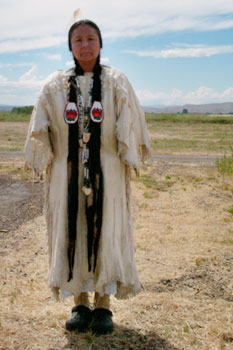
 Virginia Beavert
Virginia BeavertAuthor
Virginia Beavert is a native speaker of the lower Yakima R. dialect of
Sahaptin. She grew up near Zillah, and has lived around Toppenish most
of her life. She received a B.S. in Anthropology from Central
Washington University in 1986; Master of Education,
Bilingual/Bicultural Education, University of Arizona, Tucson, 2000;
and a Doctorate of Humane Letters from the University of Washington in
2009. Virginia's role in the project was to create sentences for
words in the dictionary, model the correct pronunciation of the words
and sentences on the 9830 recorded sound files, help decipher
Pandosy's spellings, and from time to time ask Sharon, "is X in the
dictionary?" In addition to her role as linguistic expert on this
project, she also served as cultural authority.
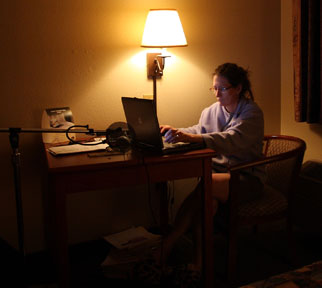 Sharon Hargus
Sharon HargusProfessor of Linguistics, UW
Author
Sharon's role was to ask questions of Virginia, create and develop the database, determine what
needed to be recorded, record and process sound files, edit the book
manuscript, write 2 introductory essays, set and maintain minimum
quality standards, identify needed images and obtain them, and coordinate various parts and people of the project.
Website: http://faculty.washington.edu/sharon/
Photo: Working on the dictionary at Toppenish Best Western motel, May 2008. Photo by Dave Paul Nelson.
Photo: Working on the dictionary at Toppenish Best Western motel, May 2008. Photo by Dave Paul Nelson.

 Bruce Rigsby
Bruce RigsbyAuthor
Bruce Rigsby contributed important essays to the front
matter on the etymology of the names ''Sahaptin'' and ''Yakama/Yakima''.
He also scanned 409 pages from his field notebooks in the 1960s and
1970s and made them available for consultation during the development
of the dictionary.
Left Photo: At a meeting of researchers and scholars at Tamastslik Cultural Institute in September, 2004 to discuss draft
entries for the atlas of Sahaptian placenames (photo by Eugene Hunn).
Right Photo: Sample page from notebook 18, (1967-71), taken from fieldnotes with Alex Saluskin on 8-17-67. The project was guided by his insights and numerous writings about Sahaptin, which began with his 1965 dissertation Linguistic relations in the Southern Plateau (University of Oregon, Department of Anthropology) and have continued to the present day.
 Dave Paul Nelson
Dave Paul NelsonPhotographer
Seventy-nine of the images in the printed dictionary (some of these
groups of 2 or 3 photos), as well as the cover photograph and most of
the photographs in the front matter, were taken by Dave Nelson.
He is married to Sharon Hargus.
While a student at the University of Alaska Fairbanks, Dave received photographic training from Barry McWayne, UAF museum photographer and well-known photographer and professor Jimmy Bedford. He went on to work as the senior photographer and photo unit manager for the UAF archives between 1978-85. He has varied photographic interests, including outdoor and wildlife photography; sports, dance, fashion and glamor; and underwater.
While a student at the University of Alaska Fairbanks, Dave received photographic training from Barry McWayne, UAF museum photographer and well-known photographer and professor Jimmy Bedford. He went on to work as the senior photographer and photo unit manager for the UAF archives between 1978-85. He has varied photographic interests, including outdoor and wildlife photography; sports, dance, fashion and glamor; and underwater.
Photo: Dave Paul Nelson looking for bighorn sheep on the west side of the Yakima R. canyon (photo by Sharon Hargus). This photo-shoot resulted in the images of the bighorn sheep and the
golden eagle which were included in the printed dictionary.
 Terry Mullen
Terry MullenPhotographer
Assistant Professor of Visual Arts, Heritage
University. She contributed four of the photographs in the printed
dictionary. She has been a faculty member at Heritage University for
24 years, and teaches Art History, Painting, Metalsmithing and a design
course. Her love is Acrylic Painting.
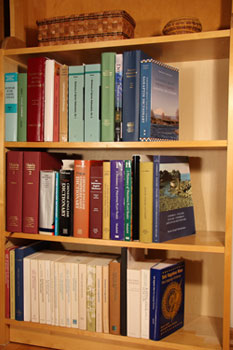 R o b e r t H s u
R o b e r t H s uProgrammer
R o b e r t H s u is a retired professor of linguistics from the University of Hawaii. He developed the
Lexware suite of programs, which have been used to create many
bilingual dictionaries for diverse languages and language families.
Bob's programs work with a plain text database.
Lexware modules were used for the Sahaptin dictionary to generate
cross-references to other entries within the Sahaptin-English
dictionary, generate the English-Sahaptin and root indices, and
convert the database, as well as the generated
finderlist and root index, to .rtf (Rich Text Format) files, while inserting
photos in the right places.
(The .rtf files were then converted to .indd by the design/layout team.)
Bob also
consulted on appropriate structuring of the data in the database, and made many useful organizational suggestions.
Bob has just written another Lexware module which generates cross-references to example sentences. Sharon is using this for another dictionary project.
Bob has just written another Lexware module which generates cross-references to example sentences. Sharon is using this for another dictionary project.
Photo: Bob's bookcase of dictionaries (photo by Dave Paul Nelson). The databases
from which these dictionaries were produced were all managed at some
stage, if not entirely, with Lexware programs or their precursors.
The first published dictionary in the bookcase is Vern Carroll and
Tobias Soulik's (1973) Nukuoro Lexicon (University of Hawaii Press).
This dictionary was created with a precursor to Lexware, which
ran on the University of Hawaii mainframe. The data and programs were at first stored on punch cards, beginning in
1967.
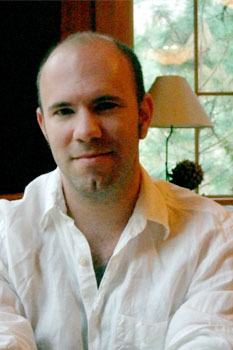 William McNeill
William McNeillSoftware Developer
In 2008, while a graduate student in the Department of
Linguistics, Bill wrote a Python script which checked for consistency
between the sound file names and dictionary entries. Bill's script
superceded one written in 2006 for the project by then-graduate
student Jonathan North Washington.
Website: http://staff.washington.edu/billmcn/
Photo: by Jodi R. James.
 Yakima Valley Museum
Yakima Valley Museum
16 artifacts photographed by Dave Nelson belong to the Yakima Valley Museum.
Special thanks go to curator Mike Siebol, who responded instantly to
Sharon Hargus's e-mail request for photographic access to their
collection, and graciously facilitated our day-long photo-shoot there
in May 2008.
Website: www.yakimavalleymuseum.org
 Museum of History and Industry
Museum of History and Industry
1 image in the dictionary comes from their image collection.
Website: www.seattlehistory.org
 NW Museum of Arts and Culture
NW Museum of Arts and Culture
5 images in the dictionary comes from their image collection.
Website: www.northwestmuseum.org
 Whatcom Museum
Whatcom Museum
1 image in the dictionary comes from their image collection.
Website: www.whatcommuseum.org
 Ryan Goelzenleutcher
Ryan Goelzenleutcher
Ryan Goelzenleuchter is a graphic designer and manager of
the pre-press department at Towner Press, Inc. He is an expert in Adobe
InDesign and worked with Russ to design the layout for the
book, wrote the paragraph styles and master page scripting,
supervised the importing of the database output files into
InDesign, and worked with Sharon on the final photo layout
of the Sahaptin-English section to condense white space and
stay under the publishers page limit.
Website: www.townerpress.com
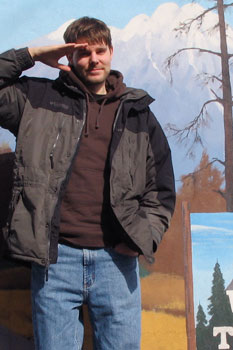 Russell Hugo
Russell Hugo
Russell Hugo helped Sharon a lot with all kinds of projects, beginning during 2007-8 as first-year
Research Assistant to the Department of Linguistics, and continuing
after the RAship ended. Russ edited all of the photos, creating the
many groupings of images seen throughout the dictionary; prepared a
first draft of the map; recruited and worked with Ryan on designing
layout for the book; converted the front matter and files generated
from the database to InDesign; tutored Sharon in InDesign as needed;
designed the layout of the web page, and wrote the style sheet for it,
overcoming many vexing font issues; and served as all-around go-to guy
for the project. He is currently holds a Staff Assistantship at
the Language Learning Center, University of Washington.
Website: LLC Staff
 Joshua Crowgey
Joshua Crowgey
During the summer of 2008 Joshua Crowgey listened to over 9000 sound files and identified poor quality
sound files (e.g. sound of a large truck in the background). The
worst approximately 500 of these were then rerecorded before the
dictionary was finished. Joshua entered the graduate program in
Linguistics in 2009 and is working with Sharon Hargus on developing
methods for web posting of multi-media texts.
 Eugene Hunn
Eugene HunnProfessor Emeritus, Anthropology,
University of Washington
An enrolled member of the Yakama Nation, participated in a photo-shoot for the dictionary outside Satus
Longhouse during July 2007. Eugene Hunn also helped with many plant
identifications throughout the course of the project, and in 2009 made
available his unpublished place name manuscripts for consultation. He
is the author (with assistance from the late James Selam) of
Nch'i-Wána, "the big river": Mid-Columbia Indians and Their Land, and
one of the authors of the forthcoming Caw Pawa Laakni / They Are Not
Forgotten: Sahaptian Place Names Atlas of the Cayuse, Umatilla, and
Walla Walla.
 Aileen Mansfield
Aileen Mansfield
an enrolled member of the Yakama Nation and 2007-8
Miss Native Heritage University, participated in a photo-shoot for the
dictionary on what happened to be the coldest day in January 2008.
There are four photographs of Aileen in the dictionary, modelling
traditional clothing and/or dancing.
 Noel Rude
Noel Rude
Noel Rude, tribal linguist, Confederated Tribes of the Umatilla Indian
Reservation, read and commented on a
2007 draft of the dictionary. He supplied an unpublished Klikitat
dictionary (image from that dictionary) for consultation, and is
directly or indirectly responsible for many of the grammatical
features included in the dictionary. Since his days as a graduate
student in Linguistics at the University of Oregon (1985 PhD
dissertation Studies in Nez Perce Grammar and Discourse), he has
specialized in Sahaptin and Nez Perce. Among other publications, he
and Bruce Rigsby are the author of the 1996 article ''Sketch of
Sahaptin, a Sahaptian Language'').
''Every time I think I've figured out something about Sahaptin, it turns out Noel has known it for a long time.'' --Sharon Hargus
''Every time I think I've figured out something about Sahaptin, it turns out Noel has known it for a long time.'' --Sharon Hargus
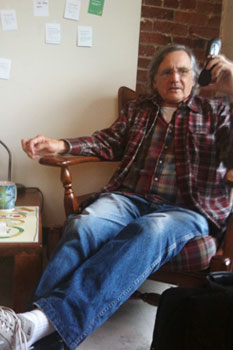 Henry Zenk
Henry Zenk
Henry Zenk, Portland State University, is one of the world's leading experts on Chinook Jargon, as well as the early
history of the northwest. He read and commented on the Chinook Jargon
identifications and sources in the 2007 draft, and suggested
additional CJ sources for some words from an unpublished CJ dictionary.
Denny Hall, Room 108 Box 353140 Seattle, WA 98195
Phone: (206) 543-0536
Email: llc@u.washington.edu






























